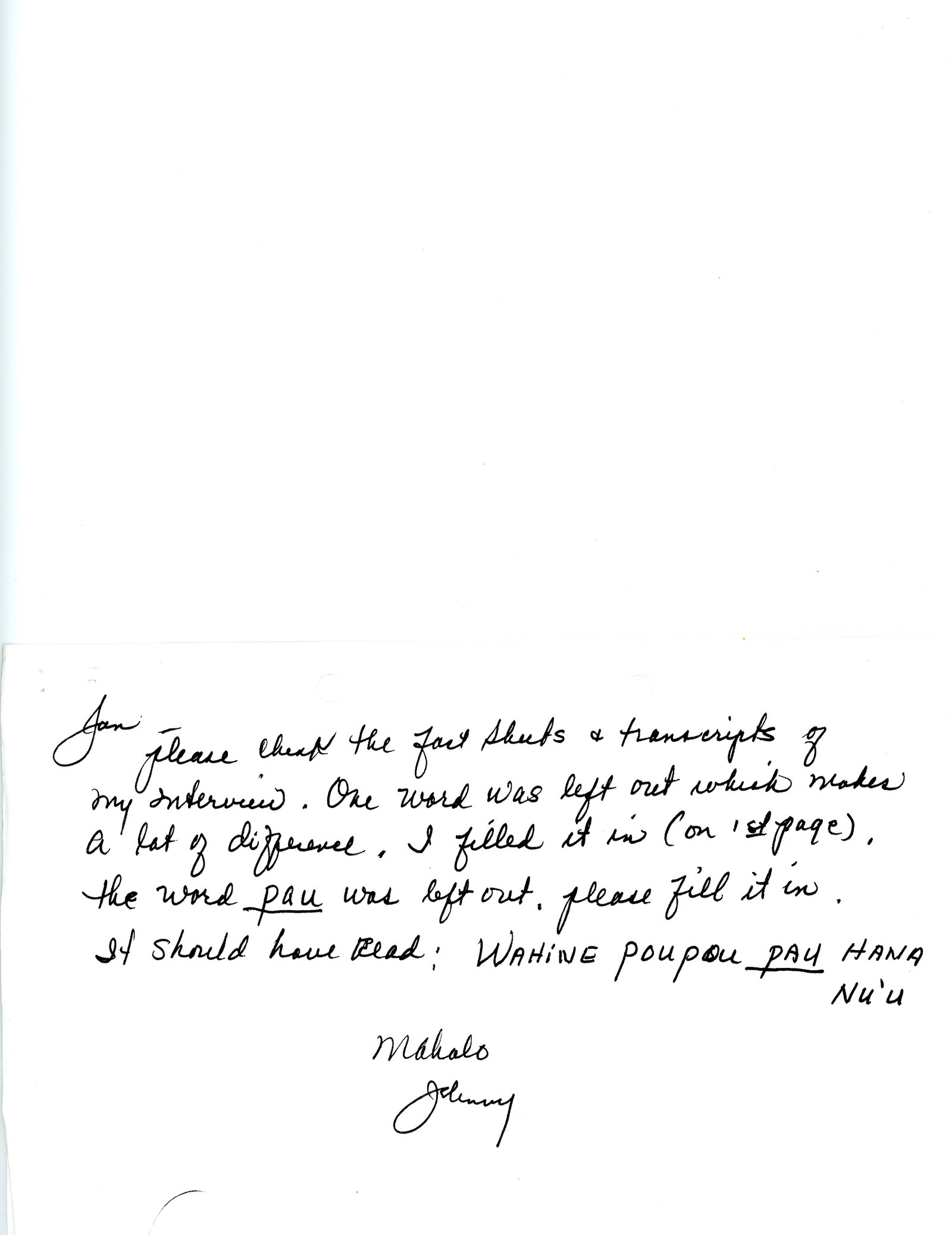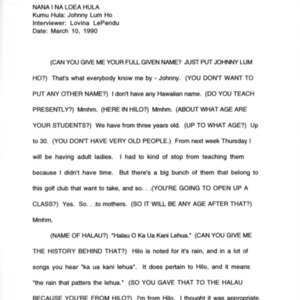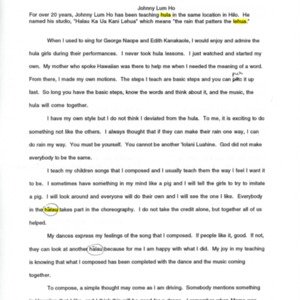Johnny Lum Ho
Title
Johnny Lum Ho
Subject
Nā Kumu Hula Johnny Lum Ho - Nānā I Nā Loea Hula Volume 2 Page 72
Description
For over twenty years Johnny Lum Ho has been teaching hula at the same location in downtown Hilo. He named his studio Hālau Ka Ua Kani Lehua which means “the rain that patters the lehua. ”
When I used to sing for George Nā‘ope and Edith Kanaka‘ole, I would enjoy and admire the hula gills during their performances. I never took hula lessons. I just watched and started my own. My mother who spoke Hawaiian was there to help me when I needed the meaning of a word. From there I made my own motions. The steps I teach are basic steps and yon can pick it up fast. So long you have the basic steps, know the words and think about it, and the music, the hula will come together.
I have my own style but I do not think I deviated from the hula. To me it is exciting to do something not like the others. I always thought that if they can make their rain one way, I can do rain my way. You must be yourself. You cannot be another ʻIolani Luahine. God did not make everybody to be the same.
I teach my children songs that I composed and I usually teach them the way I feel I want it to be. I sometimes have something in my mind, like a pig, and I tell the girls to try to imitate a pig. I will look around and everyone will do their own and I will see the one I like. Everybody in the hālau takes part in the choreography. I do not take the credit alone but together all of us help.
My dances express my feelings of the song that I composed. If people like it, good.
If not, they can look at another hālau because for me I am happy with what I do. My joy in my teaching is knowing that what I composed has been completed when the dance and the music come together.
For a competition I take time to choose the song and I already know which girl I want because I can see how her expression and moves are going to be. That is how my Miss Aloha Hula is chosen. To me the judges are just a little portion of the whole crowd who paid to come and see you. And if I captivate them all, right on! When the crowd appreciates you, you know you’ve excited them. You know that you came across to them just the way you wanted to.
To compose, a simple thought may come as I am driving. Somebody mentions something in Hawaiian that I like and I think this will be good for a dance. I remember when Mama was alive. She mentioned the wahine pou pou pau hana nu‘u. I think, “Oh, that sounds nice.” I know it will be nice in a dance. So with a story and a simple word, the music and dance will come together. And with those words, I already know which girl will dance the song.
To me my compositions are in the old style because it is an old story with old words made into a dance, but some people will say no because it is not a song that was handed down. To me it is an ancient story even if you write it and dance it now. That’s kahiko. There is no one alive today from the ancient times to put old stories together as it was when they were alive. If they were alive today, I would gladly ask them. The clothes and style one wears might be old but the body that wears it is young.
When I used to sing for George Nā‘ope and Edith Kanaka‘ole, I would enjoy and admire the hula gills during their performances. I never took hula lessons. I just watched and started my own. My mother who spoke Hawaiian was there to help me when I needed the meaning of a word. From there I made my own motions. The steps I teach are basic steps and yon can pick it up fast. So long you have the basic steps, know the words and think about it, and the music, the hula will come together.
I have my own style but I do not think I deviated from the hula. To me it is exciting to do something not like the others. I always thought that if they can make their rain one way, I can do rain my way. You must be yourself. You cannot be another ʻIolani Luahine. God did not make everybody to be the same.
I teach my children songs that I composed and I usually teach them the way I feel I want it to be. I sometimes have something in my mind, like a pig, and I tell the girls to try to imitate a pig. I will look around and everyone will do their own and I will see the one I like. Everybody in the hālau takes part in the choreography. I do not take the credit alone but together all of us help.
My dances express my feelings of the song that I composed. If people like it, good.
If not, they can look at another hālau because for me I am happy with what I do. My joy in my teaching is knowing that what I composed has been completed when the dance and the music come together.
For a competition I take time to choose the song and I already know which girl I want because I can see how her expression and moves are going to be. That is how my Miss Aloha Hula is chosen. To me the judges are just a little portion of the whole crowd who paid to come and see you. And if I captivate them all, right on! When the crowd appreciates you, you know you’ve excited them. You know that you came across to them just the way you wanted to.
To compose, a simple thought may come as I am driving. Somebody mentions something in Hawaiian that I like and I think this will be good for a dance. I remember when Mama was alive. She mentioned the wahine pou pou pau hana nu‘u. I think, “Oh, that sounds nice.” I know it will be nice in a dance. So with a story and a simple word, the music and dance will come together. And with those words, I already know which girl will dance the song.
To me my compositions are in the old style because it is an old story with old words made into a dance, but some people will say no because it is not a song that was handed down. To me it is an ancient story even if you write it and dance it now. That’s kahiko. There is no one alive today from the ancient times to put old stories together as it was when they were alive. If they were alive today, I would gladly ask them. The clothes and style one wears might be old but the body that wears it is young.
Citation
“Johnny Lum Ho,” Nā Kumu Hula Archive, accessed December 13, 2025, https://nakumuhula.org/archive/items/show/134.












